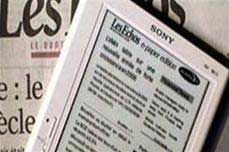 This April, De Tijd, a Belgian financial newspaper, has begun releasing a version of “electronic paper”: a device with a touch screen, low energy consumption, and using digital ink.
This April, De Tijd, a Belgian financial newspaper, has begun releasing a version of “electronic paper”: a device with a touch screen, low energy consumption, and using digital ink.
This technology was previously depicted in the sci-fi action film Minority Report, where a passenger on the subway reads USA Today through a thin, foldable video screen connected wirelessly.
However, this is no longer just a cinematic fantasy. This month, De Tijd has initiated the release of several “electronic paper” versions: devices with touch screens, low power consumption, and digital ink – millions of capsule microdots that are as wide as a hair, capable of displaying black and white images depending on the electric current.
This is just one of the trials of electronic paper devices, aiming to transform them into the “iPod of the journalism industry.” The Herald Tribune, part of The New York Times company, is also considering launching articles on a similar product to De Tijd by the end of this year.
The device used by De Tijd is called iLiad, produced by iRex (a subsidiary of Philips Electronics). Sony is also set to release an electronic paper device that can download books, newspapers, and podcasts for around $400. These products weigh approximately 0.3 kg (light enough to be held with one hand), can update information as they connect to Wi-Fi hotspots or the Internet, and allow page turning with a touch button.
“Readers often check the news before heading to work, and we release our paper before 7:30 AM, but that’s not enough,” said Kris Laenens, project director for electronic paper at De Tijd. “We need to provide information anytime and anywhere they need it.”
Although electronic paper cannot display colors and only has 16 shades of gray, it is still attracting advertisers to participate in the trials. Information segments can change depending on the time of day, thus avoiding beer ads in the morning and coffee ads in the evening.
Les Echos, currently owned by Pearson (the parent company of The Financial Times), is approaching the technology from a different angle. Instead of directly transferring the print format to the device, the company customizes the data to make it look like a website version.
“Many publishers are seriously considering electronic paper technology, and this is truly a new information channel. Some organizations also want to be the first to establish a new market,” remarked Jochen Dieckow, head of business and research at the journalism organization IFRA (Germany).

















































